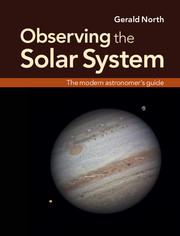Book contents
- Frontmatter
- Contents
- Preface
- Acknowledgements
- Chapter 1 Earth and sky
- Chapter 2 Moon and planet observer's hardware
- Chapter 3 The Solar System framed
- Chapter 4 Stacking up the Solar System
- Chapter 5 Our Moon
- Chapter 6 Mercury and Venus
- Chapter 7 Mars
- Chapter 8 Jupiter
- Chapter 9 Saturn, Uranus and Neptune
- Chapter 10 Small worlds
- Chapter 11 Comets
- Chapter 12 Our daytime star
- Appendix 1 Telescope collimation
- Appendix 2 Field-testing a telescope's optics
- Appendix 3 Polar alignment
- Index
- Frontmatter
- Contents
- Preface
- Acknowledgements
- Chapter 1 Earth and sky
- Chapter 2 Moon and planet observer's hardware
- Chapter 3 The Solar System framed
- Chapter 4 Stacking up the Solar System
- Chapter 5 Our Moon
- Chapter 6 Mercury and Venus
- Chapter 7 Mars
- Chapter 8 Jupiter
- Chapter 9 Saturn, Uranus and Neptune
- Chapter 10 Small worlds
- Chapter 11 Comets
- Chapter 12 Our daytime star
- Appendix 1 Telescope collimation
- Appendix 2 Field-testing a telescope's optics
- Appendix 3 Polar alignment
- Index
Summary
The small, rocky, innermost worlds of the Solar System collectively form the terrestrial planets. Further from the Sun are the large gaseous bodies of Jupiter, Saturn, Uranus and Neptune. These are known as the gas-giant planets. The name of the first of these, Jupiter, has linguistic links to good humour and jollity. Indeed, ‘Jovian’, pertaining to Jupiter, is the origin of ‘jovial’. This major planet is the easiest on which to see details through any telescope of limited size. Also, those details are subject to such rapid changes that one can never be sure what Jupiter will look like anytime one goes to the eyepiece. These attributes ensure that Jupiter is always a rewarding target for observers of all levels of experience.
THE JOLLY CREAM GIANT
Jupiter is the largest planet in our Solar System, having a volume 1300 times that of the Earth. Its bulk contains the equivalent of 317 Earth-masses but its average density is very much less than the Earth's, being a mere 1300 kg/m3. This great globe orbits the Sun at a mean distance of 778 million kilometres, i.e. 5.2 astronomical units (AU).
Jupiter takes 4332.6 days to trundle once round its orbit, so the Earth does not have to go a lot further than once round the Sun to catch up with it as each successive opposition comes round. Consequently oppositions of Jupiter come along every 399 days, on average.
- Type
- Chapter
- Information
- Observing the Solar SystemThe Modern Astronomer's Guide, pp. 229 - 268Publisher: Cambridge University PressPrint publication year: 2012



